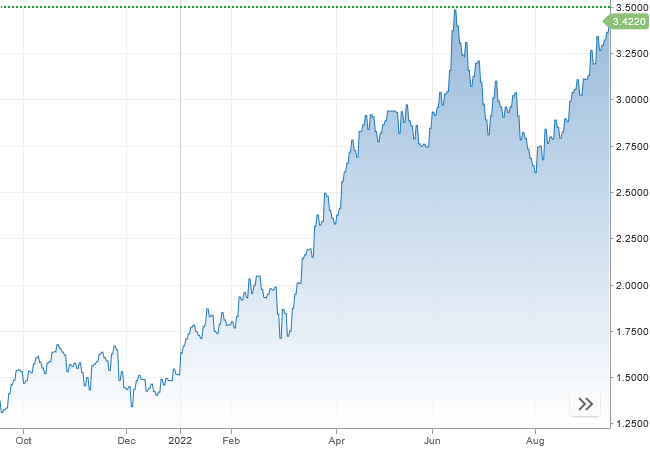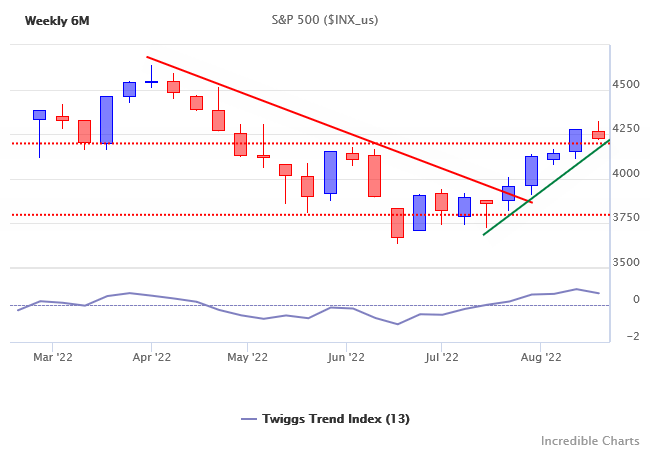The ASX 200 completed a double-bottom reversal with breakout above 7100, suggesting another test of resistance at 7600. The signal is strengthened by subsequent retracement that respected the new support level at 7100, as well as 100-day Momentum crossover above zero.

Australian Bond ETFs are forming a base, signaling that expectations of long-term interest rates have plateaued.

A-REITs rallied off support at 1200, penetrating the descending trendline which suggests that a base is forming. However, the move has not been confirmed by 100-day Momentum which remains well below zero.

Financials have made a stronger recovery, breaking above their August high, with Momentum crossing above zero. We expect a test of 7000.

Housing price growth is slowing as the RBA hikes interest rates.

But low unemployment keeps bank loan impairments down.

Net interest margins remain under pressure, however, as liquidity tightens.

Consumer Discretionary continues to test resistance at 3000 but respect remains likely, which would warn of further consolidation.

Staples rallied off long-term support at 12000 but Momentum remains below zero. Breakout above resistance at 13000 would signal another test of 14000.

A higher trough on Health Care and 100-day Momentum cross to above zero are bullish signs. Breakout above 44K would signal another advance, with a target of 49K (44K + 44K – 39K).

Information Technology remains weak, with 100-day Momentum deep below zero. Expect another test of 1250.

Utilities broke resistance at 8400, signaling an advance. Momentum crossover to above zero strengthens the bull signal..

Industrials are headed for another test of resistance at 6700. But further ranging between 6000 and 6750 remains likely.

Telecommunications are slowly edging towards resistance at 1500 but Momentum below zero indicates weakness.

Energy remains in a long-term up-trend, testing resistance at 12000. Retracement that respects support at 11000 would strengthen the bull signal.

The ASX 300 Metals & Mining index broke resistance at 5650, signaling an up-trend. Retracement that respected the new support level and 100-day Momentum cross to above zero both strengthen the bull signal.

But weakness in major metal groups makes us wary. Declining iron ore prices are testing support at 90. Breach would signal a test of $50/tonne

Base metals are similarly testing support at 150. Breach would warn of another test of 100.

The All Ordinaries Gold Index broke through resistance at 5500, with retracement respecting the new support level to confirm the breakout. But 100-day Momentum is a long way below zero, warning buyers to be wary. Expect further tests of the new support level.

The Australian Dollar is ranging between A$2500 and A$2700 with no clear direction at present.

Conclusion
Growth in Australia is slowing but recession is unlikely unless there is a sharp rise in unemployment — and fall in the housing market — or a global recession.
ASX 200 completed a double-bottom reversal, offering a target of 7600, but we do not believe this to be the start of a bull market. A negative yield curve in the US, warning of a recession next year, makes a bull market unlikely. Respect of resistance at 7600 would confirm that we are still in a bear market.
Our weighting for ASX sectors (ST = short-term, LT = long-term):
- A-REITs: ST underweight, LT overweight in industrial REITs
- Financials: overweight
- Staples: overweight
- Discretionary: ST underweight, LT neutral
- Utilities: overweight
- Industrials: neutral
- Telecommunications: neutral
- Health Care: overweight
- Information Technology: underweight
- Energy: overweight
- Iron ore & Base Metals: ST underweight, LT neutral
- Critical Materials: heavily overweight
- Gold: ST neutral, LT overweight





















































